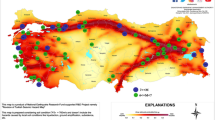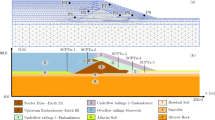Abstract
Earthquake-induced deformations for a bridge approach earth embankment are predicted using a calibrated numerical model. The constitutive soil model is a modified hyperbolic model that uses Masing rules and incremental pore pressure relations. The model was calibrated using both laboratory and field data. A shaking table physical model was used to verify the numerical simulation. Additionally, the upper San Fernando dam was modeled to reproduce the deformations in the 1971 earthquake. The subsurface and embankment soil conditions were characterized using field and laboratory methods. The model developed was used to predict the earthquake-induced deformations of an approach embankment to Bridge A1466 in the NMSZ near Hayti, Missouri, where strong earthquakes M > 7.0 are anticipated in the next 50 years.








Similar content being viewed by others
References
Byrne PM (1991) A cyclic shear volume—coupling and porewater pressure model for sand. Second international conference on recent advances in geotechnical earthquake engineering and soil dynamics, St. Louis, Missouri, Report 1.24, vol 1, pp 47–56
Finn WDL, Yogendrakumar M, Yoshida N (1986) TARA-3: a program to compute the response of 2-D embankment and soil-structure interaction systems to seismic loadings. Department of Civil Engineering, University of British Columbia, Vancouver
Finn WDL, Sasaji Y, Wu G, Thavaraj T (1999) Stability of flood protection dikes with potentially liquefiable foundations: analysis and screening criterion. In: Proceedings of 13th annual vancouver geotechnical society symposium, Vancouver pp 47–54
Harder LF, Seed HB (1986) Determination of penetration resistance for coarse-grained soils using the becker hammer drill. Report UCB/EERC-86/06, Earthquake Engineering Research Center, University of California, Berkeley
Lin J-S, Hynes M-E (1998) Seismic discontinuous deformation analysis. In: Proceedings of the geotechnical earthquake engineering and soil dynamics III, Seattle, WA, pp 790–799
Liu WX (2005) Seismic site response of deep soil and embankments in the new madrid seismic zone. Ph.D. thesis, University of Missouri-Rolla
Makdisi FI, Seed HB (1978) Simplified procedure for estimation dam and embankment earthquake-induced deformations. J Geotech Eng Div ASCE 104:849–867
Martin GR, Finn WDL, Seed HB (1975) Fundamentals of liquefaction under cyclic loading. J Geotechn Eng Div ASCE 101(GT5):423–438
Masing G (1926) Eigenshannungen Und Verestigung Beim Messing. In: Proceedings of the second international congress of applied mechanics
Moncarz P, Krawinkler H (1981) Theory and application of experimental model analysis in earthquake engineering. Rpt No 50, John Blume Earthquake Eng Ctr, Stanford University
Muraleetharan KK, Mish KD, Yogachandran C, Arulanandan K (1988) DYSAC2: dynamic soil analysis code for 2-dimensional problems, Department of Civil Engineering, University of California, Davis, California
Newmark N (1965) Effects of earthquakes on dams and embankments. Geotechnique 15(2):139–160
Prevost JH (1981) DYNAFLOW: a nonlinear transient finite element analysis program. Department of Civil Engineering, Princeton University, Princeton, NJ
Rathje EM, Bray JD (1999) An examination of simplified earthquake-induced displacement procedures for earth structures. Can Geotech J 36(1):72–87
Seed HB, Lee KL, Idriss IM, Makdisi F (1973) Analysis of the slides in the San Fernando dams during the earthquake of February 9, 1971. Report No. EERC 73–2. University of California, Berkeley
Serff N, Seed HB, Makdisi FI, Chang CY (1976) Earthquake induced deformation of earth dams. UCB/EERC-76/04, Earthquake Engineering Research Center, University of California, Berkeley
Wartman J (1996) The effect of fly ash on the geotechnical properties of a soft clay. M. Eng. Thesis, University of California, Berkeley
Wu G (2001) Earthquake-induced deformation analysis of the upper San Fernando Dam under the 1971 San Fernando earthquake. Can Geotech J 38(1):1–15
Wu G (1998) VERSAT: a computer program for static and dynamic 2-dimensional finite element analysis of continua, release 98, Wutec Geotechnical International, Vancouver
Zienkiewicz OC, Chan AHC, Pastor M, Paul DK, Shiomi T (1990a) Static and dynamic behavior of soils: a rational approach to quantitative solutions. Part I: fully saturated problems. Proc R Soc Lond Ser A 429:285–309
Zienkiewicz OC, Xie YM, Schrefler BA, Ledesma A, Bicanic N (1990b) Static and dynamic behavior of soils: A rational approach to quantitative solutions. Part II: semi-saturated problems. Proc R Soc Lond Ser A 429:311–321
Author information
Authors and Affiliations
Corresponding author
Rights and permissions
About this article
Cite this article
Liu, W., Luna, R., Stephenson, R.W. et al. Earthquake-Induced Deformation Analysis of a Bridge Approach Embankment in Missouri. Geotech Geol Eng 29, 845–854 (2011). https://doi.org/10.1007/s10706-011-9421-1
Received:
Accepted:
Published:
Issue Date:
DOI: https://doi.org/10.1007/s10706-011-9421-1




